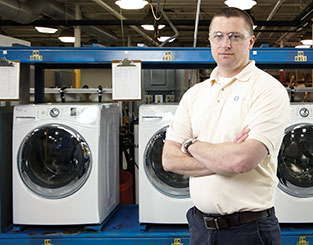
Tackling R&D with Standards
It takes good science and advanced technologies to make rubber components that keep appliances, cars and industrial machinery working smoothly. Brian Palecek of Trostel Ltd. describes how ASTM standards and other tools help his company streamline innovation, save money and improve speed to market.
Custom rubber compounds and molded products that find their way into home appliances, vehicles and a host of industrial applications have to comply with many requirements. ASTM International standards and test methods play a key role in Trostel's rigorous and unified testing approach to supplying optimized solutions for end-use products. Our materials must integrate seamlessly into our customers' products, and ASTM standards help us do this while also ensuring speed to market.
Trostel, headquartered in Lake Geneva, Wisconsin, is a technical leader in the manufacture of precision seals, custom-molded rubber products and proprietary compound mixes. We make these for the appliance, automotive and general industrial markets. Trostel is committed to advancing its long legacy of success by providing value through innovative product design and superior performance. The foundation for custom rubber product development at Trostel is ASTM procedures.
Begin with ASTM D2000
The development of a rubber compound starts with defining its end-use application, a process aided by ASTM standard D2000, Classification System for Rubber Products in Automotive Applications. While automotive is in the title of the standard, D2000 is applicable across many industries, such as oil and gas, mining, and consumer products.
ASTM D2000 contains requirements for hardness, tensile strength and elongation. It includes numerous suffixes that define how a rubber compound must function under specific heat and fluid conditions, each with its own ASTM designation. In addition, a "Z" suffix allows for any special requirements to be defined, capturing the nuances of an application.
The optimizations of compound, part and mold design are completed iteratively with computer modeling. The tensile test in D2000 determines ultimate tensile strength and elongation but also provides uniaxial stress strain data that can be used with finite element analysis. FEA allows for the part design to be analyzed prior to building a mold. This analysis allows us to identify potential failures and make changes in the design, compound or both. Since this is a computer model, numerous design iterations can be completed in a short time, reducing time to market. Once the part design is optimized, mold design optimization follows.
ASTM testing and Simulation Moldflow software are used to optimize the mold design. Simulation Moldflow allows Trostel to model the flow and curing of rubber in a mold. This system is complex, and we need accurate information about the rheological and thermal properties of the rubber.
As the rubber flows into the mold, its temperature is increasing from the hot mold as well as shear heating. How fast the rubber's temperature increases is defined by its shear viscosity (measured by ASTM D6204), thermal conductivity (D5930) and specific heat capacity (E1269).1
Heating the rubber causes it to cure. The use of cure kinetics, measured by ASTM standard D5289, Test Method for Rubber Property-Vulcanization Using Rotorless Cure Meters, and the aforementioned test methods, minimizes the amount of time the rubber is cured to obtain optimal properties, thereby reducing costs. In addition, mold-flow modeling can show areas that would not fill with rubber allowing for optimal sprue placement, or part redesign prior to building a physical mold. With Simulation Moldflow modeling, Trostel can reduce mold development time by as much as 25 percent.
In Action
An example of how these tools coalesce involves Trostel's recent development of an antifungal seal for front-loading washing machines. As the popularity of front-loading washing machines has increased, so have complaints about mold and mildew developing on door seals.
To solve the industrywide problem, Trostel used ASTM G21, Practice for Determining Resistance of Synthetic Polymeric Materials to Fungi, as a way to validate the custom rubber compound. After successfully combating the fungus growth, Trostel incorporated ASTM G21 into ASTM D2000 as a "Z" suffix for continuing quality control in its own company documentation.
Next, it optimized the design with FEA and Simulation Moldflow. While FEA didn't reveal any issues, the use of Simulation Moldflow proved crucial in the mold design. It showed how the door seal is an asymmetrical part, which means the rubber flow paths needed to be of different lengths to ensure enough rubber makes it to each section of the part. By using the software to simulate the mold filling prior to building the mold, Trostel was able to significantly reduce development time.
Trostel's formula for success involves a holistic offering of molding and compounding expertise that solves customers' unique challenges. The formula is strengthened by ASTM standards and test methods that serve as the backbone of customer rubber product development, especially since they define the most basic properties - from hardness all the way up to the most advanced computer simulations. In the end, Trostel and our customers win as our products deliver peak performance in a diverse range of demanding applications.
Reference
1. ASTM D6204, Test Method for Rubber-Measurement of Unvulcanized Rheological Properties Using Rotorless Shear Rheometers; ASTM D5930, Test Method for Thermal Conductivity of Plastics by Means of a Transient Line-Source Technique; and ASTM E1269, Test Method for Determining Specific Heat Capacity by Differential Scanning Calorimetry.
Company Snapshot
- Trostel Ltd.
- Lake Geneva, Wisconsin
- Technical leader in the manufacturing of precision seals, custom-molded rubber products and proprietary compound mixes for the appliance, automotive and general industrial markets
- Market: Global
- Number of staff: 50
Brian Palecek is technical manager at Trostel Ltd. He leads the company's Materials Development Group and Rubber Consulting Services. He also oversees the Part Validation Laboratory, which serves as the company's test lab designed specifically to test solutions for functionality and durability. He has 15 years of experience in the rubber industry and is a Six Sigma Black Belt.
 SN Home
SN Home Archive
Archive Advertisers
Advertisers Masthead
Masthead RateCard
RateCard Subscribe
Subscribe Email Editor
Email Editor